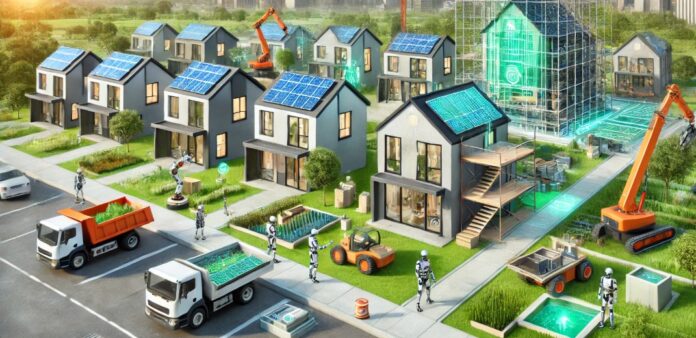The landscape of homebuilding is undergoing a remarkable transformation. With innovation and technology leading the way, Rockford Homes is spearheading the movement toward creating contemporary and sustainable spaces. These changes aren’t just trends; they signify a rethinking of what homebuilding can and should be. This renewed focus on innovation is reshaping communities, creating homes pleasing to the eye and kind to our planet.
This article explores the new trends and technological innovations transforming the homebuilding sector. It covers everything from the integration of sustainable practices to the transformation of home design through technology. Expect to explore the industry’s future through the lens of these innovative developments, offering insights into how they benefit homeowners and the broader environment.
Introduction to Modern Homebuilding
The modern era of homebuilding represents a fusion of time-honored craftsmanship and cutting-edge technology. This industry has become a crucible of creativity and innovation, offering a balance between aesthetic beauty and functional living spaces that are efficient and stylish.
Contemporary homebuilders are increasingly concentrating on developing living spaces that address the requirements of today’s lifestyles, highlighting sustainability and intelligent design. Homebuyers expect more from their living spaces as urban and suburban landscapes evolve. A newfound emphasis on functionality, efficiency, and resilience prompts builders to rethink conventional approaches. Homebuilders today face a marketplace that demands flexibility, creativity, and respect for the environment, requiring a careful balance of traditional techniques and new methodologies.
Influence of Technology in Home Construction
Technology integration in home construction has ushered in a new era of unprecedented precision and efficiency. Methods have become popular since they lower the time and expenses linked to conventional building practices. These technologies allow builders to construct homes faster without compromising quality, opening the door to new design possibilities and innovations. The practical advantages of these methodologies are significant.
For example, 3D printing can generate intricate shapes that are challenging to form with traditional methods. At the same time, modular construction enables components to be built off-site and assembled on-site, reducing waste and disturbance. With the ongoing advancements in these technologies, they are set to transform the possibilities in homebuilding.
Sustainable Building Practices
Sustainability has transitioned from a buzzword to a primary focus in modern home construction. Builders are increasingly incorporating eco-friendly materials and practices to minimize environmental impact. These efforts manifest in various ways, such as deploying solar panels, rainwater harvesting systems, and energy-efficient windows that offer substantial cost savings in the long run.
This sustainable approach reduces the reliance on finite resources and helps reduce a home’s overall carbon footprint. Eco-conscious consumers drive demand for green building solutions, leading many builders to adopt these practices as standard. By making homes more energy-efficient and environmentally friendly, modern builders are not just creating shelters; they are fostering homes that harmonize with nature, reducing their environmental impact while enhancing residents’ quality of life.
Innovations in Home Design
Home design is undergoing a renaissance, with new trends emphasizing openness, flexibility, and connectivity to nature. Minimalism, characterized by simple and functional spaces, is paired with biophilic design, which integrates nature into architectural spaces.
This trend reflects a movement toward more adaptable living environments where individuals can enjoy the benefits of a closer connection to nature. Open floor plans that allow for multipurpose use of space have become increasingly popular, allowing homeowners to tailor spaces according to their needs.
These trends align with the growing desire for homes that serve as personal sanctuaries and accommodate the shifting demands of work, family, and leisure.
The Role of Smart Homes
As technology permeates every aspect of life, smart home features have become more than just a luxury—they’re quickly becoming a standard in modern home design. Thanks to systems that control lighting, heating, security, and appliances, smart homes provide unmatched convenience, security, and energy efficiency.
Features like automated lighting and voice-activated systems allow personalized control over the domestic environment. Smart technology enhances comfort and convenience and significantly contributes to energy savings. As this technology evolves, it’s expected to connect more seamlessly into daily life, making homes more intuitive and connected than ever before.
Advanced Building Materials
The use of advanced materials is revolutionizing the homebuilding industry. Materials like cross-laminated timber and self-healing concrete are at the forefront of this transformation, characterized by their strength, durability, and sustainability. These materials offer enhanced performance while being eco-friendly, significantly impacting how new homes are built. Cross-laminated timber streamlines the building process while offering excellent strength and stability. Meanwhile, self-healing concrete can extend a building’s lifespan by automatically repairing cracks, reducing maintenance costs, and increasing safety. By adopting these materials, builders can create structures that stand the test of time while respecting environmental considerations.
Conclusion
The outlook for home construction is bright, propelled by incorporating advanced technologies, eco-friendly methods, and state-of-the-art materials. These trends offer significant environmental benefits and enhance the quality, comfort, and functionality of modern living spaces. As technology advances and sustainability becomes increasingly crucial, the homebuilding industry is set to forge new paths that align with the needs and values of future generations, redefining the environments we call home.


